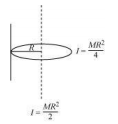Question 7. 10. (a) Find the moment of inertia of a sphere about a tangent to the sphere, given the moment of inertia of the sphere about any of its diameters to be , where M is the mass of the sphere and R is the radius of the sphere.
(b) Given the moment of inertia of a disc of mass M and radius R about any of its diameters to be find the moment of inertia about an axis normal to the disc passing through a point on its edge.



© 2025 GoodEd Technologies Pvt. Ltd.